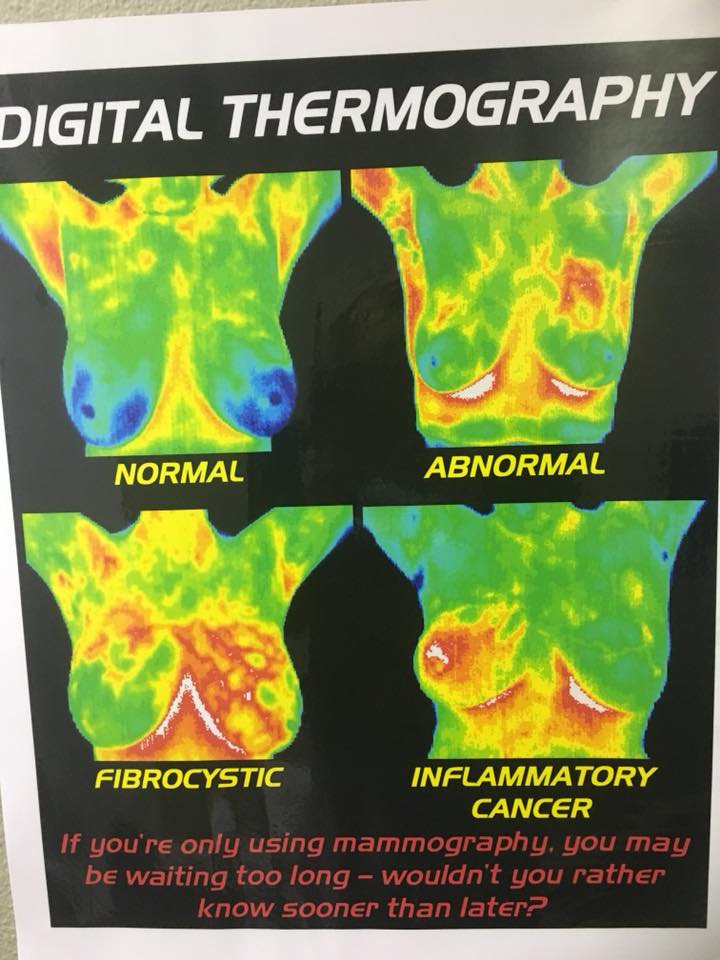6 Reasons I Get Annual Thermography Scans
📸 Standing in front of a camera getting pictures taken of my boobs… let me just add that to the list of the things I’ve done in the name of health. 😉
It’s all good though! I consider thermography one of the many tools I use as part of my proactive health strategy.
Before we get started, let me preface this by saying: I am NOT a doctor nor do I play one on the internet. I am a nutritionist who is passionate about preventative healthcare - not reactive sickcare - and what I’m sharing here is part of my personal health plan. I have discussed it with my doctor and so should you if this is something you are considering. My goal here is to introduce you to thermography as a screening option and share my experience.
ALWAYS speak with your doctor before making any medical decisions.
How thermography works
Thermography uses a small infrared camera which takes thermal images- think “night vision” goggles!- of the body. Areas with a higher metabolic activity (read: abnormal cell growth with the potential to become cancer) will require more nutrients, and therefore, higher amounts of blood-flow. These areas are easily distinguished from normal, benign cells by a color difference which is detected by the thermogram. 🌡
This is what potential results may look like…
Thermography can detect abnormal cell growth before it becomes cancer..
I often get asked if I use thermography in place of mammograms. As of now, I’ve only had thermography. Being under 50 and having no family history of cancer, I am currently comfortable with this choice. I also regularly perform self-breast exams. This may not be the best choice for you. Again, it is very important to consult your doctor. That said, let me give you a little more information about thermography.
6 reasons why I choose thermography
1. Thermography is approved by the FDA as an adjunct to mammography.
And the USPSTF (the US Preventative Services Task Force) now says that regular mammograms should begin at age 50 (not 40) and that mammograms should be done every 2 years rather than annually due to concerns with radiation.
2. Thermography can detect cancer up to 8-10 years EARLIER than conventional mammograms.
This is huge! The thermogram can detect increased metabolic activity at the cell level and doesn’t wait for these cells to multiply to the point where a tumor is present. In other words, a mammogram can only detect a bigger mass whereas thermography can pick up potential suspicious activity years before. Why wait til it gets to the tumor stage?
It can even detect changes to cell in the armpit area which helps you assess your lymph nodes. Mammograms detect STRUCTURE while thermograms detect FUNCTION. The function (physiology) of the cells changes before those changes are physically evident! So thermograms give you an advantage in detecting changes earlier before tumors grow.
3. Mammograms emit harmful radiation (which can speed cancer cell growth and proliferation) while thermography is completely free of radiation. Because of this, thermography can be used in younger women (mammograms are usually not recommended in women under 40 who don’t have a family history of breast cancer due to concerns with frequent radiation exposure)
4. Mammograms are uncomfortable, while thermography is just a camera! No pain!
5. There is a reduced rate of false abnormal results with thermography compared to with conventional mammograms, especially for women with denser breast tissue. Mammogram= 65% false positive rate due to density of breast tissue and fibrocystic breast changes.
6. Thermogram results can inspire proactivity. With your results, you can shift your diet and lifestyle, reduce toxins, and relieve stress- and potentially stop cancer before it starts! This shows amazing promise for improving outcomes and promoting health.
Want to try out thermography?
Here’s what to expect…
You Cannot Be Screened If Within 3 Months…
You've had an accident, injury or surgery in the screening area
You've had a needle or surgical biopsy to the screening area
You've had radiation therapy or chemotherapy to the screening area
You've used black salve in the area to the screening area
You're pregnant, breastfeeding or lactating.
If you currently have a rash, sunburn or abrasion in the screening area, contact the thermography office!
preparing for your appointment
YOU MUST AVOID THE FOLLOWING…
2 HOURS BEFORE SCAN
Anything that could affect the dilation or constriction of your blood vessels (caffeine, tobacco or alcohol)
Anything that could affect your core body temperature (strenuous exercise or physical exertion)
Anything that causes heat to your body (extremely hot shower or sauna, prolonged sun exposure/sunburn/tanning beds)
DAY OF YOUR SCAN
Any type of body work (acupuncture, massage, extreme chiropractic adjustments)
Any topical products
Deodorant or antiperspirant
Shaving: If you choose to shave your underarms or legs, please do so the day or evening before your appointment
AT YOUR APPOINTMENT
Once you arrive at your appointment, you undress privately and will spend a few minutes with your hands above your head to allow heat from the armpits to disperse (increasing the accuracy of the thermography!). Then, the technician will take photos with an infrared camera behind a privacy screen. You change angles and she takes more pictures. Once that’s complete, the thermography images are sent to physicians who specialize in reading these and then results will be delivered to you (and your doctor, if requested!).
This is the company I use: DITI Imaging.
It costs about $250 and, unfortunately, insurance does not typically cover it.
The company I use runs a special every January that includes a free head and neck scan with breast screening.
I’d love to hear if you’ve tried thermography or similar “alternative” screening techniques! Let me know in a comment below!




